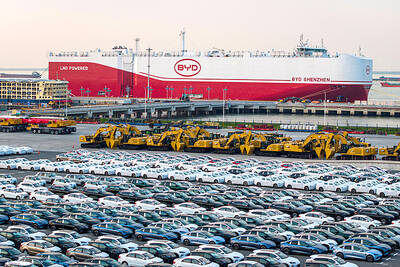Taipei Times (TT): What will be Singapore Airlines Ltd’s (SIA) most important plan for this year?
Benjamin Chan (曾國銘): One of the company’s major plans this year is to retire all of our Boeing 747 aircraft in the passenger sector, with the last commercial service to be run on March 24 and March 25, flying between Singapore and Melbourne. In addition, the company will operate special commemorative flights between Singapore and Hong Kong on April 6 to mark the retirement of the Boeing 747 planes after nearly four decades of service in SIA.
It is not easy to say goodbye to the Boeing 747, as these airplanes have played an important role in helping the company become the global airline that it is today. However, the company has to outpace the sector in upgrading the fleet, setting new benchmarks with every new generation of aircraft that we introduce to keep passengers safer and more comfortable.
TT: Is the decision to retire the Boeing 747 related to the recent rise in crude oil prices? How will the carrier deal with this oil price issue?
Chan: The rise of oil prices is absolutely the major uncertainty for the airline sector this year, while the persistently high jet fuel price has adversely affected the SIA Group’s performance. [From April to December last year, the SIA Group posted a net profit of S$374 million (US$297.89 million), a decline of 59 percent from S$921 million for the same period in 2010.]
Indeed, this is one of the major factors of the Boeing 747 planes’ retirement in SIA, as we want to promote both environmental protection and energy efficiency. Therefore, energy-saving quality will definitely be an important element for us when picking up new aircraft in the future.
TT: Since the sector met strong headwinds in the air cargo business last year amid global economic uncertainty, what is the cargo outlook this year?
Chan: The company has decided to cut the cargo sector’s capacity by 20 percent through summer to cope with a still-weak demand this year. Unlike some of our peers, SIA has not seen the necessity to take any cargo aircraft out of service thus far, but we will carefully monitor the situation to see if it is inevitable for us to idle a cargo plane.
TT: How about the passenger sector? What is SIA’s focus this year?
Chan: We will focus more on the Asia-Pacific region this year by increasing flights to India, China, Australia, Indonesia and Japan, as we are seeing more opportunities in these markets.
As for the long-haul routes that cost the company more in fuel use, we may reduce the number of direct long-haul flights flexibly to control the operational costs. For example, the company has reduced the number flights of [our] Singapore-Los Angeles route to five a week, from one a day.
TT: What about SIA’s plan for the Taiwan market this year?
Chan: The company’s strategy in Taiwan is always to create a niche in the market by offering unique travel products. We have two special travel packages this year — one is to Australia’s Darwin, while the other is to Singapore. We expect the package to Darwin will attract many Taiwanese travelers to popular tourist destinations in Australia’s Northern Territory, while the package to Singapore will highlight the Singapore Formula 1 race.

Micron Memory Taiwan Co (台灣美光), a subsidiary of US memorychip maker Micron Technology Inc, has been granted a NT$4.7 billion (US$149.5 million) subsidy under the Ministry of Economic Affairs A+ Corporate Innovation and R&D Enhancement program, the ministry said yesterday. The US memorychip maker’s program aims to back the development of high-performance and high-bandwidth memory chips with a total budget of NT$11.75 billion, the ministry said. Aside from the government funding, Micron is to inject the remaining investment of NT$7.06 billion as the company applied to participate the government’s Global Innovation Partnership Program to deepen technology cooperation, a ministry official told the

Taiwan Semiconductor Manufacturing Co (TSMC, 台積電), the world’s leading advanced chipmaker, officially began volume production of its 2-nanometer chips in the fourth quarter of this year, according to a recent update on the company’s Web site. The low-key announcement confirms that TSMC, the go-to chipmaker for artificial intelligence (AI) hardware providers Nvidia Corp and iPhone maker Apple Inc, met its original roadmap for the next-generation technology. Production is currently centered at Fab 22 in Kaohsiung, utilizing the company’s first-generation nanosheet transistor technology. The new architecture achieves “full-node strides in performance and power consumption,” TSMC said. The company described the 2nm process as

POTENTIAL demand: Tesla’s chance of reclaiming its leadership in EVs seems uncertain, but breakthrough in full self-driving could help boost sales, an analyst said Chinese auto giant BYD Co (比亞迪) is poised to surpass Tesla Inc as the world’s biggest electric vehicle (EV) company in annual sales. The two groups are expected to soon publish their final figures for this year, and based on sales data so far this year, there is almost no chance the US company led by CEO Elon Musk would retain its leadership position. As of the end of last month, BYD, which also produces hybrid vehicles, had sold 2.07 million EVs. Tesla, for its part, had sold 1.22 million by the end of September. Tesla’s September figures included a one-time boost in

Shares in Taiwan closed at a new high yesterday, the first trading day of the new year, as contract chipmaker Taiwan Semiconductor Manufacturing Co (TSMC, 台積電) continued to break records amid an artificial intelligence (AI) boom, dealers said. The TAIEX closed up 386.21 points, or 1.33 percent, at 29,349.81, with turnover totaling NT$648.844 billion (US$20.65 billion). “Judging from a stronger Taiwan dollar against the US dollar, I think foreign institutional investors returned from the holidays and brought funds into the local market,” Concord Securities Co (康和證券) analyst Kerry Huang (黃志祺) said. “Foreign investors just rebuilt their positions with TSMC as their top target,